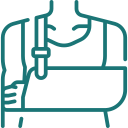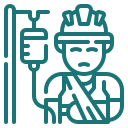Suffered an arm injury in an accident that was not your fault? Perhaps you have injured your rotator cuff while at work or hurt your wrist in a motor vehicle accident. However you have suffered the injury, you may be able to make a claim for the damage and loss you have sustained if your arm injury was caused by someone else’s negligence.
Workplace accidents make up a large proportion of Australian injuries every year. Of the 120,355 serious claims made through WorkCover in Australia in 2021, 29,680 - that is, 25% of all claims - were made for injury to the arms or upper arm/limbs. In certain situations - such as with workplace accidents - you will be able to make a claim for your injury which is covered automatically under statutory law.
In other cases, you will be able to make a claim on insurance if you were not at fault, such as if you are driving. This includes if you were the passenger in a car or if you were cycling and struck by a vehicle.
If you are considering making a claim for arm injury compensation, including for road traffic accidents, workplace accidents, public place accidents, and even sports injuries in some cases, our personal injury solicitors here at Murphy's Law can assist you with your claim. We operate on a no win no fee basis and offer a complimentary initial consultation so there is no risk associated with finding out where you stand.

Get free expert advice on your rights to an arm injury claim now
Free & no obligation claims check
Common arm injuries
The arm is a complex part of the body. There are delicate bones in the fingers and hands, large bones in the arm, soft tissue and muscles, and tendons and ligaments. While it is possible to sustain an injury anywhere on your arm, some types of arm injuries are more common than others. Listed below are some of the most common arm injuries:
- Broken bones - The radius and ulna are the bones of the forearm, and are susceptible to breaks in a number of ways. The humerus is less likely to break as a result of its position in the arm and how the arms are used, but a traffic accident can result in a broken humerus. The wrist and fingers are also prone to breaks, especially in workplace accidents or while playing sport.
- Fractures - Fractures are a common accident which can happen when the wrist or arm comes into contact with a stationary object. A fracture may be contained within the arm, or may be a compound fracture which happens where the bone which is fractured pierces the skin.
- Cuts and grazes - Cuts and grazes are common arm injuries which can happen along with other arm injuries, but can also include serious wounds, such as that which may happen in the workplace. Cuts can include the full or partial severing of a part of the arm.
- Tendon injuries - Tendons are critical for the smooth operation of the arm. Even though tendons are tough, they can be damaged if they are overused. This is due to micro-tears which can become inflamed.
- Muscle injuries - You can injure the muscles in your arm in a number of ways and can experience serious pain and suffering as a result of muscle injury. Muscle injuries may include torn or pulled muscles, and can happen in any number of ways.
- Shoulder injuries - Shoulder injuries can be debilitating as they can limit your ability to lift or lower your arm. Rotator cuff injuries are shoulder injuries which can cause serious discomfort and lack of movement in the arm and which can impact on your ability to work or enjoy daily activities without pain.
- Hand injuries - The hands are prone to injury in any number of ways. Broken bones, sprains and fractures are all common workplace injuries; even for people who work in sedentary employment such as offices, hand and wrist injuries are common.
Common causes of arm injuries
We have listed some of the most common types of arm injuries above, and now outline some of the common causes of arm injuries below. We have paid particular attention to arm injuries which can happen in the workplace, while on the road, and in public places - but arm injuries can happen in any number of ways.
- Contact with an immobile object - Arm injuries can be caused when colliding with a stationary object. For example, if you are travelling at speed, such as while riding a bicycle, and you come into contact with a car door or a car that stops suddenly, you are likely to sustain arm injuries (along with a host of other possible physical injuries). Workplace accidents can be common as well, where workers hit objects or come into contact with machinery or objects.
- Blunt force trauma - Blunt force trauma can cause broken bones, gashes, cuts, fractures, and a range of other possible arm injuries. Blunt force trauma can occur in a number of ways, for example: when you are involved in a car accident and are struck by an airbag or contact a part of the vehicle, in a workplace accident where your arm is hit by something falling or moving, or in a public place where an item falls from a height and strikes your arm.
- Machinery cuts and gashes - Workplace injuries can happen when workers are using machinery or tools which can cause cuts and gashes. These accidents can happen in a number of ways; both through machinery malfunction or improper use of machinery and also through inadequate supervision or provision of safety equipment.
- Crush injuries - Another common workplace injury is a crush injury, when the arm, hand or shoulder is trapped between two objects causing potentially serious injuries. Crush injuries can be difficult to recover from, often due to the intense injury that is suffered to a wide range of bones, ligaments, muscles and tendons.
- Accidental slipping or tripping - If you are out in a public place and slip or trip, it is common to use your arms or hands to brace your fall. This can result in a range of injuries, including jarring of the arms or shoulders, broken or fractures bones, or muscle and ligament damage.
- Falls from height - When working at height it is imperative to use adequate safety equipment. But arm injuries can happen even when falling from a short distance. Falls from height can cause broken bones, ligament or muscle damage, and even tears.
- Collision arm injuries - Being involved in a motor vehicle accident, whether as a motorist (both vehicle and motorbike), a passenger, a pedestrian, or a cyclist, can cause serious arm injury.
If your arm injury has been caused in the workplace, on the road, or in a public place as a result of someone else’s negligence, speak to our personal injury lawyers today about how we can help you with your arm injury compensation claim.
Occupations with High Arm Injury Risks
Certain professions are more at risk of suffering injury in the workplace than others. This is due to the fact that the workers in these industries are in contact with high-risk environments.
High-risk environments might include certain machinery or tools, which, if used incorrectly or if they malfunction will likely cause injury - both mild and severe. There also may be specific risks involved in particular workplaces which can cause risks, like repetitive strain injuries or sprains and strains.
- Warehouse workers - People who work in warehouses and who are required to pick and pack items manually are at an increased risk of suffering shoulder and arm pain which may be linked to their workplace. You should always have a safe system of work available to you and be able to rest and recover between shifts.
- Abattoir workers - When workers are moving heavy items, such as carcasses and machinery and tools, there is a risk of suffering arm injury due to the repetitive nature of the work.
- Offices - While not high risk for traumatic injuries such as breaks and fractures, there is a risk of suffering repetitive strain injuries such as tendon inflammation due to overuse or improper use of a mouse or keyboard.
- Trades and labourers - Working with hand tools and power tools can cause injury to the arms, both through potential trauma where accidental injury is suffered, and with injuries which can develop over time such as vibration injuries.
- Mining and engineering - People who work in mining and high-intensity environments such as underground mining and industrial tunnelling are at risk of injury to the arms both through the tools they may use or be exposed to, and through risk due to falling objects such as rock or coal or minerals.
How much compensation for an arm injury?
When making a claim for compensation for an arm injury, your potential claim will be calculated based on a range of factors and a figure will be reached which aims to place you, financially at least, in the position you would be in had the accident not occurred. A claim will include compensation for:
- Medical treatment
- Necessary and reasonable home care
- Lost wages and income, both past and future
- Medical expenses (including physiotherapy and medication)
- Pain and suffering
An arm injury, including hand and wrist injury, can be debilitating. You may not be able to return to your previous form of employment and may find that your personal injuries cause you ongoing suffering. Speak to our personal injury claims lawyers today about how we can help you achieve an outcome that is just and fair.
Time limits for arm injury compensation
When making a claim for an arm injury, there is generally a time limit in which you can claim. You have three years from the date you were injured to commence your claim for personal injury compensation. In some cases, such as where you were injured at work, you have six months to advise WorkCover of your intent to claim.
If you were injured in a road accident, you must advise any insurance companies involved of your intent to claim within nine months of your accident (or within one month of engaging a firm to act on your behalf).
Consider getting legal advice as soon as you are able, so that you have the best possible chance of making successful claims against the at-fault party. You can read more about time limits here, or speak to us for legal advice about how we can help with your claim for compensation for an arm injury.






